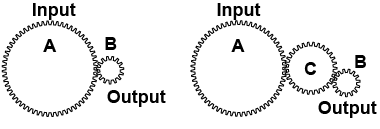- In conducting an investigation where you need to use a variety of different masses, compare the advantages of slotted masses and a small pail with sand poured into it.
- A slotted lab mass typically has a wedge removed from it (the “slot”). How does the “missing” slot affect the mass printed on the slotted lab mass?
- For the largest mechanical advantage, would you place a lever’s fulcrum closer to the input or output force?
 How can you determine to which class a lever belongs? How can you determine to which class a lever belongs?
 Using the equivalence of torques for a lever in equilibrium, find the mechanical advantage of a lever. Using the equivalence of torques for a lever in equilibrium, find the mechanical advantage of a lever.

- Gear A has more teeth than gear B.
- If gear A is the input gear, is the mechanical advantage greater than one or less than one?
- If gear B is the input gear, is the gear ratio greater than or less than one?
- When constructing a block-and-tackle system for an investigation such as 12B on page 339, why is it better to use a spool of string or nylon thread rather than an elastic band to pass over the pulleys?

- Irini has a motor that can provide 10 N m of torque. She plans to use gears to make a machine to produce 100 N m of output torque. Will the output shaft of her machine turn faster or slower than the input shaft connected to the motor? Why?
- Rosa slides a block across the table at constant speed against the force of friction. What is the efficiency at which her input work is transformed into mechanical energy of the block?
| | - Describe the relationship between the gear ratio and the mechanical advantage for a set of gears.

- Gear A has 52 teeth and gear B has 15 teeth. Gear A is used to drive gear B. Gear C has 30 teeth and is inserted between gears A and B. (In this case, gear A remains the input gear and gear B remains the output gear.)
- Does the gear ratio change when gear C is added?
- What happens to the direction of rotation of gear B?
- A system of gears has a mechanical advantage greater than one. You apply a force to the input gear and your friend applies a force to the output gear so that neither gear spins.
- Compare how much force each of you provides.
- Compare how much torque each of you provides.

- Suppose you use a wheel and axle to hold steady a load that is attached to the axle. The axle and wheel are held up by supports that are not shown.
- Does the torque from your hand on the wheel balance with the torque from the load?
- Does the strength of the force from your hand on the wheel equal the strength of the force exerted by the load?
- If either does not balance, then explain what ensures that the system remains in static equilibrium.
- Bruce needs to lift an 80 kg dishwasher from street level to the bed of a moving van, 1 m higher. He plans to put the dishwasher on a wheeled dolly and then to push it up a ramp. He has two ramps to choose from, one 5 m long and the other 8 m long. Assume there is no friction.
- Which ramp (if either) requires Bruce to push with greater force?
- Which ramp (if either) requires Bruce to do a greater amount of work?
|

